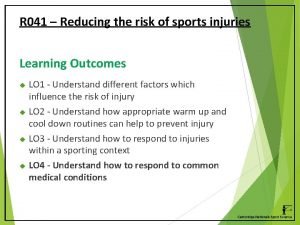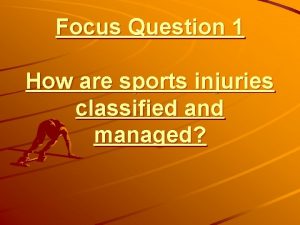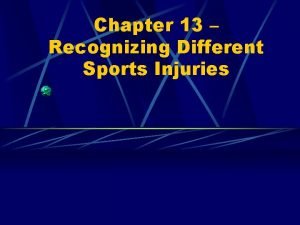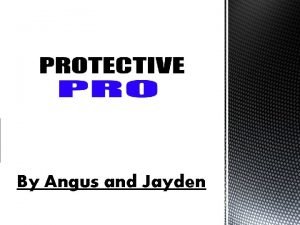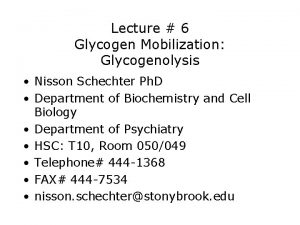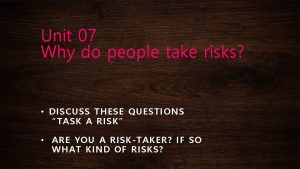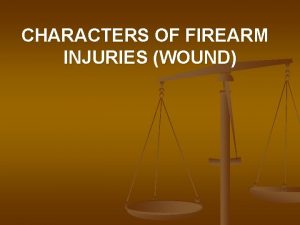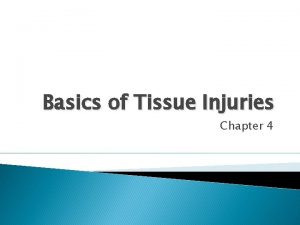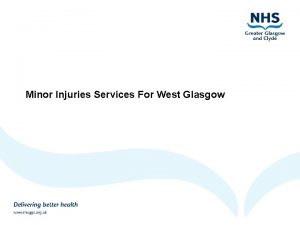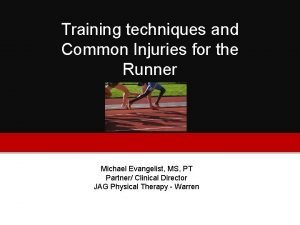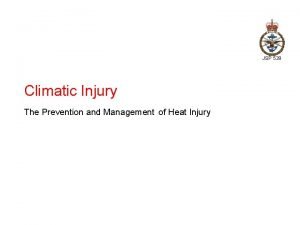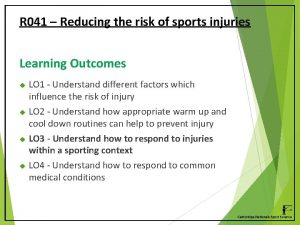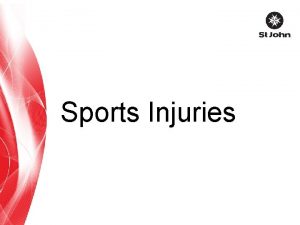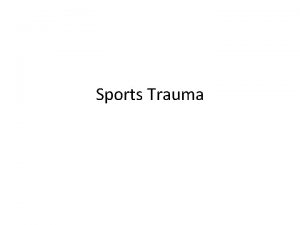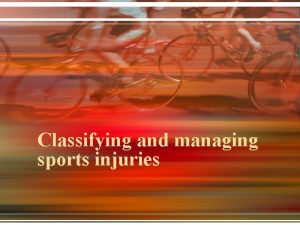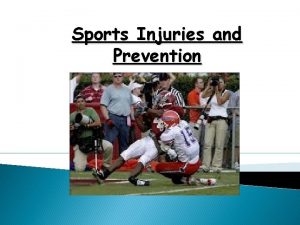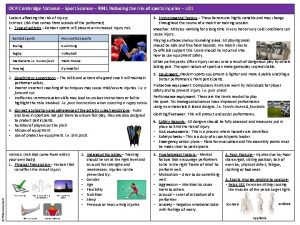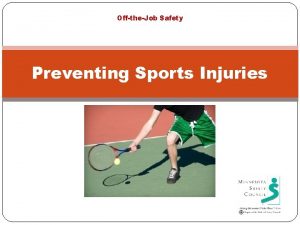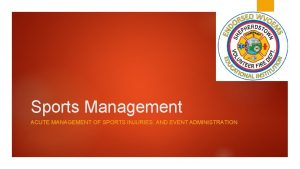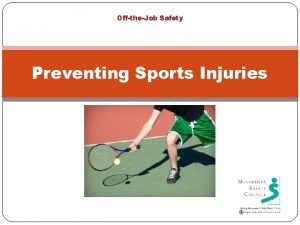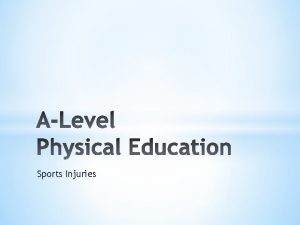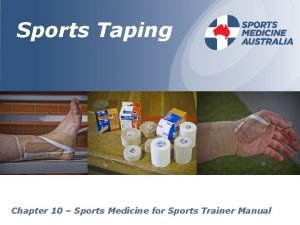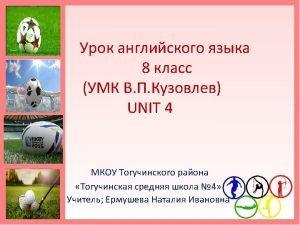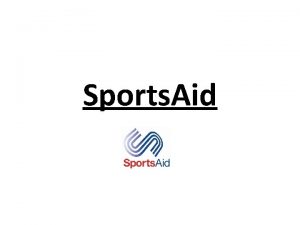R 041 Reducing the risk of sports injuries

























- Slides: 25

R 041 – Reducing the risk of sports injuries Learning Outcomes LO 1 - Understand different factors which influence the risk of injury LO 2 - Understand how appropriate warm up and cool down routines can help to prevent injury LO 3 - Understand how to respond to injuries within a sporting context LO 4 - Understand how to respond to common medical conditions

How to respond to common medical conditions Before any performer begins physical activity, they should be asked about their current health status and potential conditions that may effect their ability to exercise. Lifestyle questionnaires: Designing a training programme involves details on the clients lifestyle factors such as alcohol intake, free time, occupation and existing conditions.

How to respond to common medical conditions You must understand the symptoms and basic response to the following medical conditions: Asthma Diabetes Epilepsy Think. Pair. Share – Explain the medical conditions above and discuss ways you might respond.

Asthma Watch me Asthma attack symptoms and treatment

Asthma is a common condition where airways can become restricted. Individual’s can become wheezy and short of breath which will affect performance. The tightening of the muscles surrounding the trachea prevent gases from freely moving in or out. Regular exercise will strengthen the respiratory system and help prevent the effects of asthma. Additionally, an inhaler can be used to relax the airways and minimise the symptoms.

Asthma Symptoms of asthma/asthma attack: • Coughing • Wheezing • Shortness of breath • Tightness across the chest • Difficulty talking • Feelings of anxiety or panic • Pale and sweaty face

Asthma How to respond to an asthma attack: 1. Reassure them and ask them to breathe slowly 2. Help them use their reliever inhaler straight away. This should relieve the attack. 3. Sit them down in a comfortable position. Get them to take one or two puffs of their inhaler every two minutes, until they’ve had 10 puffs. 4. If the attack is severe and they are getting worse or becoming exhausted, or if this is their first attack, then call 999/112 for an ambulance.

Diabetes Watch me Diabetes symptoms and emergency aid

Diabetes is a lifelong condition that causes a person's blood sugar level to become too high. There are two main types of diabetes: • Type 1 diabetes (insulin dependant) – where the body's immune system does not allow insulin to be produced at all. • Type 2 diabetes (non-insulin dependant) – where the body doesn't produce enough insulin, or the body's cells don't react to insulin. Type 2 diabetes is far more common than type 1. In the UK, around 90% of all adults with diabetes have type 2.

Diabetes Symptoms of diabetes: • Increased thirst • Increased hunger (especially after eating) • Dry mouth • Frequent urination or urine infections • Unexplained weight loss (despite eating and feel hungry) • Fatigue (weak/tired feeling) • Blurred vision • Headaches

Diabetes How to respond to a diabetic emergency: Hyperglycaemia - Too little insulin cause high blood sugar. If it’s not treated and gets worse, the person can gradually become unresponsive (going into a diabetic coma) • Help them take their insulin • Call 999 or 112 straight away for medical help. • Keep checking their breathing, pulse and level of response. If they lose responsiveness at any point, open their airway, check their breathing and prepare

Diabetes How to respond to a diabetic emergency: Hypoglycaemia - Too much insulin cause low blood sugar. This often happens when someone with diabetes misses a meal or does too much exercise. • Help them sit down. • If they have their own glucose gel, help them take it. If not, you need to give them something sugary like fruit juice, a fizzy drink, three teaspoons of sugar, or sugary sweets.

Epilepsy Watch me Epilepsy symptoms and emergency aid

Epilepsy A seizure can be caused by something interrupting the electrical activity in the brain. This leads the muscles in the body to contract uncontrollably and usually causes the person to lose responsiveness. It’s also known as a convulsion or fit. With any kind of seizure it is really important to keep checking: • That they still respond and have a pulse. • That the person is breathing.

Epilepsy Symptoms of someone having a seizure: • Sudden loss of responsiveness • Rigid body with an arching back • Noisy difficult breathing • Convulsions (jerky uncontrolled movements) • Loss of bladder and bowel control • Afterwards they may be confused, tired and fall into a deep sleep

Epilepsy How to respond to an epileptic emergency: • Don’t restrain or move them. • Protect them from hurting themselves. Clear away any potentially dangerous objects, like hot drinks or sharp objects. • Make a note of the time when the seizure started and how long it lasts. • Protect their head by placing something soft underneath it, like a towel, and loosen any clothing around their neck. • Once the seizure has stopped, they may fall into a deep sleep – if they do, open their airway and check their breathing. • If they’re breathing, put them in the recovery position.

Retrieval Practice Identify the symptoms of an asthma attack. Describe how you would respond to epileptic seizure. Responding to common medical conditions Explain the procedure for dealing with a person you Suggest three symptoms of find suffering from an asthma an individual with diabetes. attack.

Exam Question Application 1. Identify three symptoms of asthma. (3) 1. . . . . . . . . . . . . 2. . . . . . . . . . . . . 3. . . . . . . . . . . . .

Exam Question Application 2. You are running a coaching session and Katherine starts to have an asthma attack. Describe how you would respond to this. (2). . . . . . . . . . . . . . . . . . . . . . . . . .

Exam Question Application 3. Oliver suffers from asthma and Jasminder suffers from epilepsy. Both attend a weekly badminton club. Describe one symptom for each that would indicate to their coach that they are having an attack and one treatment method that the coach could use in each case. (4) Oliver’s symptom . . . . . . . . . . . . . . . . . Oliver’s treatment . . . . . . . . . . . . . . . . . Jasminder’s symptom . . . . . . . . . . . . . . . . . Jasminder’s treatment . . . . . . . . .

Exam Question Application Marks Scheme: 1. Three marks from: • Coughing • Wheezing • Shortness of breath • Tightness in chest 2. Two marks from: • Calm individual down • Get individual to take inhaler • Assess the situation and call an ambulance if needed

Exam Question Application Marks Scheme: 3. Oliver's asthma symptom -wheezing -coughing -shortness of breath -breathlessness or run out of breath -difficulty breathing or heavy breathing -difficulty speaking -tightness in the chest -pale skin -clammy skin -grey/blue lips (if attack severe)

Exam Question Application Marks Scheme: 3. Oliver's asthma treatment -keep/stay calm or reassure or make light conversation -sit them down or upright -encourage them to take slow and steady breaths -use of inhaler / pump -contact emergency services (if needed)

Exam Question Application Marks Scheme: 3. Jasminder's epilepsy symptom -fits or seizures or twitching or rubbing hands together -foaming at the mouth or smacking of lips -rigidity / muscle stiffness -loss of consciousness or dizziness or collapse -blank stare -confusion -loss of bladder/bowel control -sense of 'déjà vu' -difficulty speaking - tingling (sensation)

Exam Question Application Marks Scheme: 3. Jasminder's epilepsy treatment -move objects out of the way -keep (head) safe/put cushioning under head -reassure them or calm them down -allow them to fit -after the fit is over Put them in the recovery position -seek medical advice/999
 041 0980844
041 0980844 R/041 apartment
R/041 apartment How are sports injuries classified and managed
How are sports injuries classified and managed Chapter 11 assessment and evaluation of sports injuries
Chapter 11 assessment and evaluation of sports injuries Chapter 13 worksheet recognizing different sports injuries
Chapter 13 worksheet recognizing different sports injuries Sports injuries angus, on
Sports injuries angus, on Westfield sports injuries
Westfield sports injuries Reducing vs non reducing sugars
Reducing vs non reducing sugars Glucose seliwanoff test
Glucose seliwanoff test Uridine diphosphate glucose
Uridine diphosphate glucose Fehling's test for sucrose
Fehling's test for sucrose Market risk credit risk operational risk
Market risk credit risk operational risk Indoor vs outdoor sports
Indoor vs outdoor sports Fear factor success and risk in extreme sports
Fear factor success and risk in extreme sports Injuries first aid
Injuries first aid Characters of firearm injuries
Characters of firearm injuries Chapter 4 basics of tissue injuries
Chapter 4 basics of tissue injuries Chapter 14 bleeding shock and soft tissue injuries
Chapter 14 bleeding shock and soft tissue injuries Stobhill miu
Stobhill miu Common track and field injuries
Common track and field injuries Battering intentional or unintentional
Battering intentional or unintentional Pallet jack injuries
Pallet jack injuries Climatic injuries
Climatic injuries Chapter 17:4 providing first aid for shock
Chapter 17:4 providing first aid for shock Unit 15:6 providing first aid for burns
Unit 15:6 providing first aid for burns Clinton tendonitis
Clinton tendonitis

